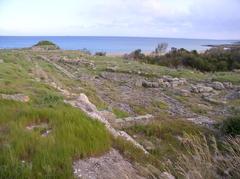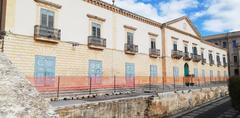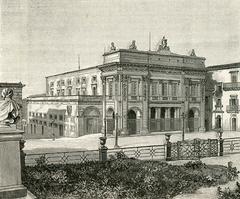Palazzo Trigona di Cannicarao: Visiting Hours, Tickets, and Historical Significance in Noto, Italy
Date: 03/07/2025
Introduction
Palazzo Trigona di Cannicarao stands as one of Noto’s grandest Baroque palaces, epitomizing the city’s aristocratic heritage and architectural splendor in southeastern Sicily’s UNESCO-listed Val di Noto. Constructed in the early 18th century after the devastating 1693 earthquake, the palace is a testament to the resilience of the Trigona family and the region’s ambitious Baroque urban renewal. Palazzo Trigona di Cannicarao is celebrated for its monumental façade, ornate interiors, and cultural significance—functioning today as both a venue for exhibitions and a luxury boutique hotel. This guide details the palace’s origins, architectural highlights, visiting hours, ticketing options, accessibility, and nearby attractions, offering travelers practical advice and enriching context for an immersive visit.
For official updates and further information, consult the Catalogo Generale dei Beni Culturali and local guides like GoAskALocal.
Table of Contents
- Introduction
- Origins and Historical Context
- Architectural Significance and Artistic Heritage
- Notable Events and Cultural Role
- Visitor Information: Hours, Tickets, Accessibility
- Highlights and Visitor Experience
- Nearby Attractions & Travel Tips
- Frequently Asked Questions (FAQ)
- Conclusion and Recommendations
- References
Origins and Historical Context
After the catastrophic 1693 earthquake destroyed the original city of Noto, the Trigona family—one of Sicily’s most prominent aristocratic lineages—commissioned the construction of Palazzo Trigona di Cannicarao as part of the city’s Baroque rebirth. Built in the early 18th century, the palace reflects the Trigona family’s social standing and their pivotal role in Noto’s post-earthquake transformation. Archival sources confirm Bernardo Labisi as the principal architect, though the spirit of the city’s leading Baroque designers is evident throughout (Catalogo Generale dei Beni Culturali; GoAskALocal).
The palace quickly became a hub of aristocratic life, hosting gatherings, political meetings, and cultural events that shaped the social fabric of Noto.
Architectural Significance and Artistic Heritage
Palazzo Trigona di Cannicarao is the largest palace in Noto’s historic center and is regarded as the second most beautiful Baroque residence after Palazzo Nicolaci (Catalogo Beni Culturali; byemyself.com). It is designed in a U-shaped plan, featuring:
- Façade: Divided into two horizontal orders and three vertical sections, with monumental Corinthian pilasters and two lateral turrets. The central balcony is supported by a double row of pilasters and crowned with a broken tympanum bearing the Trigona eagle crest—a symbol shared with the city of Noto (SiciliaFan).
- Ornamentation: Nine “panciuti” (bulging) wrought-iron balconies, grotesque masks, floral bas-reliefs, and intricate stuccoes.
- Interiors: Grand salons adorned with original frescoes by Antonio Mazza, polychrome stuccoes, and 18th-century Sicilian craftsmanship. The piano nobile (noble floor) houses lavish reception rooms and, uniquely, a private chapel.
- Courtyard and Gardens: The entrance opens to a central courtyard with terraced gardens, offering tranquility amid the city bustle.
Heraldic eagles, family crests, and playful Baroque motifs reinforce the palace’s aristocratic identity and its role in Noto’s urban ensemble (The World of Sicily).
Notable Events and Cultural Role
Historically, the palace was a focal point for the Trigona family’s social, political, and religious activities. In the 20th century, part of the building passed to the Municipality of Noto and was repurposed for cultural initiatives, such as the Circolo Val di Noto and the Istituto di Scienze Criminali di Siracusa (byemyself.com). Following restoration, Palazzo Trigona di Cannicarao now hosts exhibitions, concerts, and prestigious events, especially during Noto’s famed Infiorata festival (Finestre sull’Arte).
Portions of the palace are operated as a boutique hotel, allowing guests to experience Sicilian aristocratic life in an authentic Baroque setting (Sicilia Secrets).
Visitor Information: Hours, Tickets, and Accessibility
Opening Hours
- Municipal Section (Exhibitions & Events): Open primarily during scheduled events and exhibitions. Hours vary; consult the official Noto tourism website or Info Point Noto for current details.
- Hotel Section: Access is exclusive to hotel guests or special event attendees.
- Typical Exhibition Hours: Tuesday–Sunday, 9:00 AM–6:00 PM; closed Mondays and public holidays.
Tickets and Reservations
- Admission Fees: Usually €7–€10 for municipal exhibitions; some events may be free. Payment is typically cash only.
- Guided Tours: Available during special events or by advance request.
- Hotel Stays: Exclusive access to private salons and terraces for hotel guests (Sicilia Secrets). Advance booking is essential.
Accessibility
- The palace’s historic architecture means some areas are accessible only via stairs or uneven surfaces. Main public areas offer limited wheelchair access; contact the Info Point in advance for detailed information.
Photography
- Allowed in public exhibition spaces; restrictions may apply in private or hotel areas. Always ask before photographing interiors.
Highlights and Visitor Experience
- Façade & Balconies: Admire the monumental stonework, baroque masks, and “panciuti” balconies along Via Cavour.
- Grand Salons: During exhibitions or guided tours, visitors can view frescoed halls, stuccoed ceilings, and period furnishings.
- Courtyard & Gardens: The central courtyard and terraced gardens offer peaceful retreats and scenic photo spots.
- Symbolic Details: Look for eagles and heraldic motifs, emblematic of both the Trigona family and the city of Noto.
Nearby Attractions & Travel Tips
- Noto Cathedral: Just steps away, the cathedral is the city’s Baroque centerpiece.
- Palazzo Nicolaci: Renowned for its elaborate balconies and opulent interiors.
- Corso Vittorio Emanuele: Noto’s main street, lined with cafés, shops, and historic palaces.
- Dining: Sample Sicilian pastries at Caffè Sicilia or enjoy local cuisine at nearby trattorias (Travels with Missy).
- Best Visit Times: Spring and autumn offer pleasant weather and fewer crowds. The Infiorata di Noto in May is a highlight.
- Parking & Transport: Paid parking is available on the city outskirts; the palace is a short walk from public transport stops.
Frequently Asked Questions (FAQ)
Q: When is Palazzo Trigona di Cannicarao open to the public?
A: The municipal (event) section is open during scheduled exhibitions and events, typically Tuesday–Sunday, 9:00 AM–6:00 PM. Check the official tourism website for updates.
Q: How do I buy tickets?
A: Tickets are sold at the entrance during events (cash only). For special tours or events, advance booking may be available.
Q: Is the palace fully wheelchair accessible?
A: Accessibility is limited due to historic architecture; contact staff in advance for assistance.
Q: Can I take photos inside?
A: Photography is generally allowed in public areas during exhibitions, but ask staff for specific restrictions.
Q: Are guided tours available?
A: Guided tours are offered during some events or by request; check with the Info Point or tourism office.
Q: Can non-hotel guests visit all areas?
A: No; the boutique hotel section is exclusive to guests or event attendees. Public access is limited to municipal exhibition spaces.
Conclusion and Recommendations
Palazzo Trigona di Cannicarao is a cornerstone of Noto’s Baroque heritage, blending aristocratic grandeur, architectural innovation, and vibrant cultural life. Whether you’re admiring the façade, exploring exhibition halls, or staying in the boutique hotel, the palace offers an authentic immersion into Sicily’s noble past.
To make the most of your visit:
- Confirm current opening hours and event schedules online.
- Purchase tickets in advance for popular events or guided tours.
- Combine your visit with nearby attractions for a full Baroque Noto experience.
- Download the Audiala app for immersive audio guides and updated cultural listings.
For more detailed insights, consult the Catalogo Generale dei Beni Culturali and trusted local travel guides such as GoAskALocal.
References
- This is a sample text. (Catalogo Generale dei Beni Culturali)
- This is a sample text. (GoAskALocal)
- This is a sample text. (byemyself.com)
- This is a sample text. (Finestre sull’Arte)
- This is a sample text. (Sicilia Secrets)
- This is a sample text. (SiciliaFan)
- This is a sample text. (The World of Sicily)
- This is a sample text. (Travels with Missy)
- This is a sample text. (Italy This Way)
For images, maps, and event calendars, visit the official tourism sites or download the Audiala app for interactive experiences.




